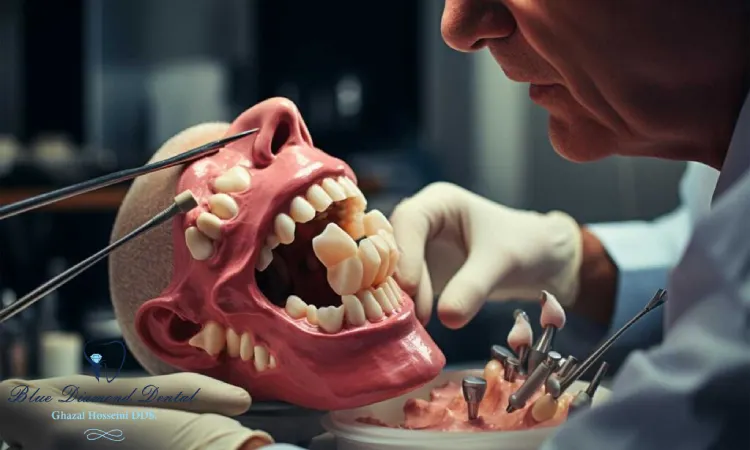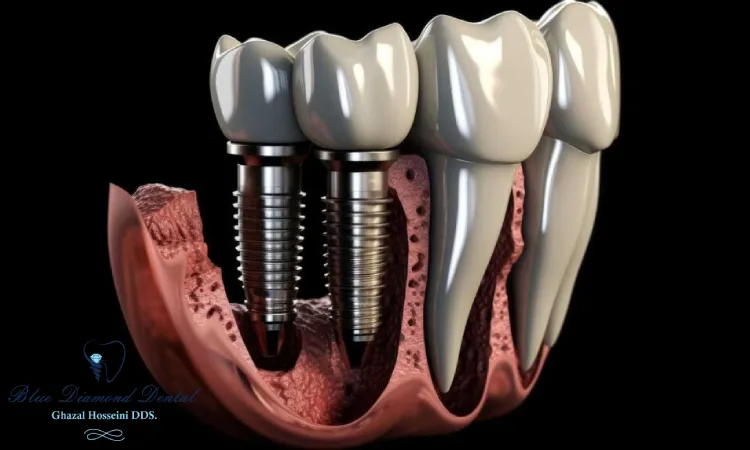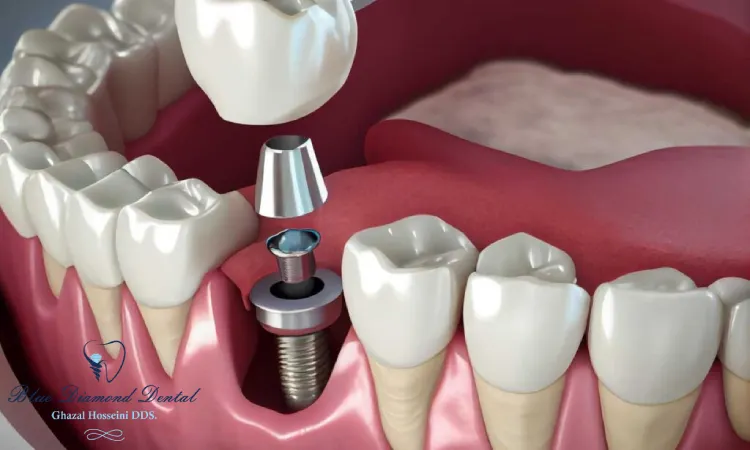- Home
- Services in Blue Diamond Dental

Orthodontics

Pediatric Dentistry
Dental Space Maintainers
Fluoride Treatment
Dental Pulp Treatment
Dental Sealants
Dental Fillings

Cleaning & Prevention

Surgical Dentistry
Tooth extraction
Tooth Extraction Membrane Fell Out
Surgical Placement
Dental bone graft - Contact Us
- About Us
Dental implant surgery
Dental implant surgery is an incredible procedure that is transforming the world of dentistry. Gone are the days of uncomfortable dentures or gaps in your smile when you have missing teeth.
One fascinating aspect of dental implant surgery is how it imitates the natural structure and function of our teeth. Unlike bridges or dentures, dental implants are surgically placed directly into the jawbone and fuse with the bone through osseointegration. This integration provides stability and durability comparable to natural teeth, allowing patients to eat and speak with confidence.
Don’t let missing teeth hinder your confidence any longer. Schedule your dental implant surgery today and restore your smile with a lasting solution. Our experienced team in BLUE DIAMOND DENTAL is ready to provide you with the personalized care you deserve – take the first step towards a healthier, more vibrant life now!
Additionally, dental implant surgery offers long-term benefits beyond its aesthetic appeal. When a tooth is lost or extracted, the underlying bone begins to deteriorate due to a lack of stimulation from chewing and biting forces. By placing an implant into the jawbone, this degeneration is prevented or significantly reduced as the artificial root functions similarly to a natural tooth root. This preserves facial structure and prevents issues like sunken cheeks or sagging lips associated with bone loss, ensuring better overall oral health for years to come.
In conclusion, dental implant surgery is an innovative approach to restoring missing teeth that offers more than just cosmetic improvements.

You can also get Dental porcelain crown services from Blue Diamond Dental With the best price along with the most advanced modern equipment
What Is the Purpose of a Dental Implant Procedure?
The objective of this surgery is to restore mouth functionality, which may be affected by missing teeth that make it difficult to chew certain foods and speak clearly. Dental implants are a long-lasting solution that can replace an entire tooth structure, including the root, enabling individuals to eat comfortably and speak without impediments.
Moreover, dental implants play a crucial role in preserving oral health. When a tooth is lost, the jawbone in that area may deteriorate due to lack of stimulation from chewing forces, leading to additional dental problems such as shifting teeth or further bone loss. Placing an implant into the jawbone stimulates new bone growth and prevents further deterioration. This keeps remaining natural teeth stable and maintains proper facial structure, ensuring a youthful appearance for longer.
In summary, dental implant surgery aims to restore functionality and promote overall oral health by preventing further damage, not just filling gaps caused by missing teeth.
If you’re planning to have a dental implant procedure, it’s important to prepare properly. First, schedule a consultation with your dentist to discuss your expectations and ask any questions or concerns you may have. This will help you understand the procedure and what to expect.
Good oral hygiene is also crucial before the surgery. Regular brushing and flossing can help reduce the risk of infection during the implantation process. Quitting smoking beforehand can also aid in better healing and reduce complications.
It’s important to arrange for transportation after the surgery, as you may feel groggy or dizzy from anesthesia. Additionally, stocking up on soft foods like soups and mashed vegetables can make mealtime easier during recovery.
By following these steps, you can ensure that you’re fully prepared for your dental implant procedure and optimize your healing process afterward.
Types of Dental Implant Procedures
A well-known method for dental implants is Endosteal implants. These implants involve placing titanium posts directly into the jawbone, which provides a stable base for prosthetic teeth. This method is commonly used for patients who have sufficient healthy bone structures.
For patients who do not have enough jawbone to support traditional implants, Subperiosteal implants are a common solution. This method involves placing a custom-made metal frame beneath the gum tissue but above the jawbone. Over time, the frame fuses with the bone, creating a stable base for artificial teeth.
Zygomatic implants are another option for patients with severe bone loss in their upper jaws. Instead of relying on the deteriorated or insufficient jawbone, longer screws are anchored into the cheekbones. This innovative approach allows even those who were previously deemed inoperable candidates to receive dental implants and restore their smiles.
Overall, dental implant procedures have significantly advanced, providing patients with different options for tooth replacement and effectively addressing different cases.
How painful is getting a tooth implant?
Getting a tooth implant may seem intimidating at first, but most patients report experiencing only mild discomfort during the process. Local anesthesia is used during the procedure to ensure that patients feel minimal pain. However, it’s important to keep in mind that some discomfort may be experienced as the body heals in the days following the surgery. Fortunately, over-the-counter pain medications can help manage any discomfort that is felt.

It’s important to note that everyone’s pain tolerance is different, so what may be mildly uncomfortable for one person may be more painful for another. However, many dentists take measures to ensure that their patients are comfortable throughout the entire process, such as offering conscious sedation or nitrous oxide (laughing gas) for those who experience anxiety during dental procedures. This is a testament to how modern dentistry prioritizes patient comfort and satisfaction every step of the way.
How long does dental implant surgery take?
When it comes to replacing missing teeth, dental implant surgery is a popular and effective option. Patients often wonder about the length of the procedure. The duration of the surgery varies based on the patient’s oral health, the number of implants needed, and any additional procedures required.
On average, the surgery can take anywhere from one to several hours. The initial stage involves evaluating the patient’s teeth and jawbone through X-rays and digital scans to determine the best placement for the implants. This careful planning ensures a successful outcome and reduces the likelihood of complications. During the surgical procedure, a small incision is made in the gum tissue to reveal the underlying bone where each implant will be placed. Once the implant is securely in position, temporary crowns or bridges may be fitted while the area heals.
While some patients may be apprehensive about the length of time spent in the dentist’s chair during the surgery, it’s important to remember that investing in the procedure is crucial for achieving long-lasting results. Furthermore, advancements in technology have significantly streamlined the process in recent years, reducing discomfort and recovery times. With proper care before and after the procedure, patients can soon enjoy their favorite foods with the confidence of a strong new smile and improved bite for years to come.
What are the steps in dental implant surgery?
Having dental implant surgery can be a life-changing experience that not only brings back your smile but also restores your confidence. However, it’s important to understand the process before diving into the details of the surgery itself.
The first step is an examination by a skilled dentist or oral surgeon to determine if you are a suitable candidate for implants. If you are, the next step is creating a personalized treatment plan that considers factors such as the number of teeth to be replaced, overall oral health, and bone density.
Preparing the mouth for surgery is crucial. This may involve removing damaged teeth or ensuring proper healing from previous extractions. Bone grafting may also be necessary to provide support for the implant.

During surgery, small incisions are made in the gum tissue to expose the jawbone. Titanium screws, called dental implants, are inserted into the jawbone to replace natural tooth roots. The implants integrate with the jawbone over several months.
After osseointegration is complete, abutments are attached to the implants in preparation for dental crowns, which are custom-made artificial teeth. These crowns are created using impressions taken after recovery from surgical procedures. Regular check-ups and X-rays confirm stability before attaching the crowns.
What are the 3 stages of dental implants?
The process of dental implant treatment involves three stages that work together to provide patients with a natural-looking and fully functioning smile.
The first stage is the initial consultation, during which the dentist assesses the patient’s oral health to determine if they are a suitable candidate for dental implants. This evaluation includes taking X-rays or CT scans to evaluate bone density and determine the best placement for the implants. The dentist will also discuss any necessary pre-surgical preparations, such as removing damaged teeth or treating gum disease.

The second stage is implant placement, which involves a minor surgical procedure. During this stage, titanium posts are inserted into the patient’s jawbone to serve as artificial tooth roots. Over time, the jawbone fuses with these posts through a process called osseointegration, ensuring the stability and durability of the new prosthetics. After this procedure, several months must pass for osseointegration to occur before proceeding to the final stage.
The third and final stage is restoration. Once osseointegration is complete, the dentist creates custom-made crowns or dentures that blend seamlessly with the patient’s existing teeth in terms of size, shape, and color. These restorations are then securely attached to the implants using abutments or connectors. The result is a fully restored smile that not only looks natural but also functions properly for biting and chewing.
Each of these three stages is crucial in ensuring the success of dental implant treatment.
How Long Is the Recovery After a Dental Implant Procedure?
The amount of time it takes for a dental implant to fully integrate with the jawbone can vary depending on different factors. Typically, patients can expect an initial healing period of 3-6 months, during which they may experience some mild pain or discomfort. Their dentist can prescribe over-the-counter pain medication to manage any discomfort.
After the initial healing period, the dental implant restoration process continues with the placement of a crown or prosthetic tooth onto the implant. This typically occurs 2-4 weeks after the initial surgical procedure, once the implant has properly fused with the jawbone. Patients may experience slight soreness in their gums during this phase, but discomfort is usually minimal.
It’s important to keep in mind that every patient’s recovery process is unique and depends on factors such as overall oral health and adherence to post-operative care instructions. While it’s natural to be concerned about recovery time, patients should trust in their dentist’s expertise and remain patient throughout each stage of treatment.

